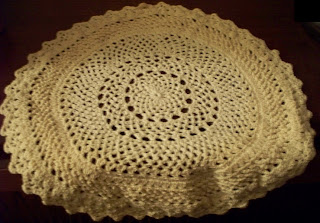Swirl -A colorwork hat, worked in the round-
This is my attempt to create a pattern for a hat I improvised.
The chart is based on a much larger chart created by Jessica Tromp.
I chose to use a G hook to help keep the stitches tighter so that the carried yarn doesn't show as much through the stitch work.
 MATERIALS:
MATERIALS:DK weight yarn:
-about 150 yds of the main color
-about 100 yds of white.
G hook (4.0 mm)
I used Red Heart Boutique Unforgettable, which is listed as worsted but works more like DK, and Bernat Baby Coordinates.
FINISHED SIZE:
Based on your head size...
FINISHED SIZE:
Based on your head size...
STITCHES USED:
sc- single crochet
dc- double crochet
fpdc- front post double crochet
bpdc - back post double crochet
dc- double crochet
fpdc- front post double crochet
bpdc - back post double crochet
INSTRUCTIONS:
Main Body-
The chart is in 20-stitch repeats, so measure the circumference of your head and work a starting chain, in multiples of 20, that is closest to your head size. I chose to go slightly larger because this hat does not have a lot of "stretch" to it. My starting chain was 120 stitches. Join the chain to form a ring.
Mark the join, so you can tell where your rounds begin.
The only stitch used for the chart is single crochet (sc).
Work 6 rounds in the main color, as shown in the color chart below.
When indicated in Row 6 of the chart, join white and continue working in sc as the chart shows, in continuous rounds. (Working in continuous rounds prevents an obvious "seam" in the finished project).
Cut and work in the main color after completing round 23.
Work 2 rounds in white, as indicated in the chart.
Round 26: After the second row of solid white (row 25), begin decreasing to create the top of the hat. I decreased every 5th stitch for about 8 rows.
By round 33 or 34, there should be a very small opening left in the hat. Finish the opening by cutting about 4" of the white yarn, and weave it through the remaining stitches. Pull that single strand of yarn tightly to gather the opening closed, then tie off on the wrong side (inside) of the hat and work the loose end in to hide it.
Edging-
To finish the opening of the hat, rejoin the main color to the opening chain
Round 1: Work dc in each ch all around (120 dc, or whatever number of chains you needed to fit your head).
Join the last dc to the first dc with a slip stitch, ch3.
Round 2: Begin forming a ribbed effect. Work fpdc in next dc, bpdc in dc repeat alternating fpdc and bpdc around edge. Join last fpdc to beginning ch3 with slip stitch. Ch 3.
Round 3 and 4: repeat round 2, working fpdc in the fpdc below and bpdc in the bpdc below to create a ribbed effect.
Cut main color, tie off and work in the end to hide it.
I hope you have success with this hat, and enjoy wearing it!

































